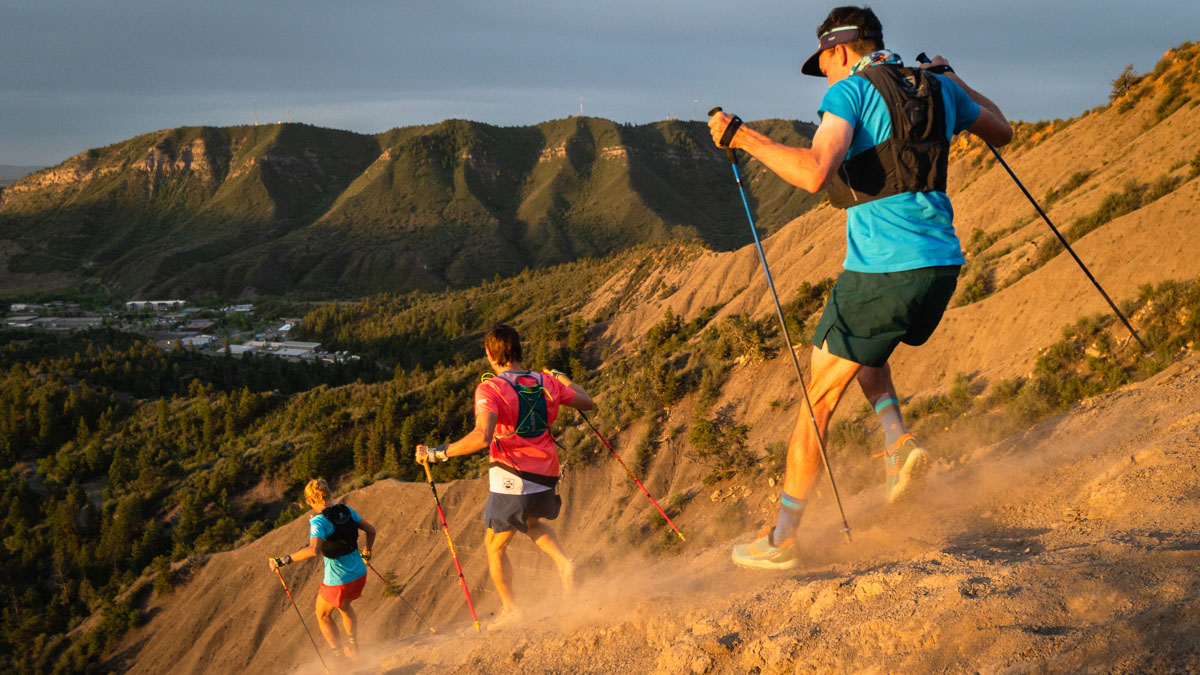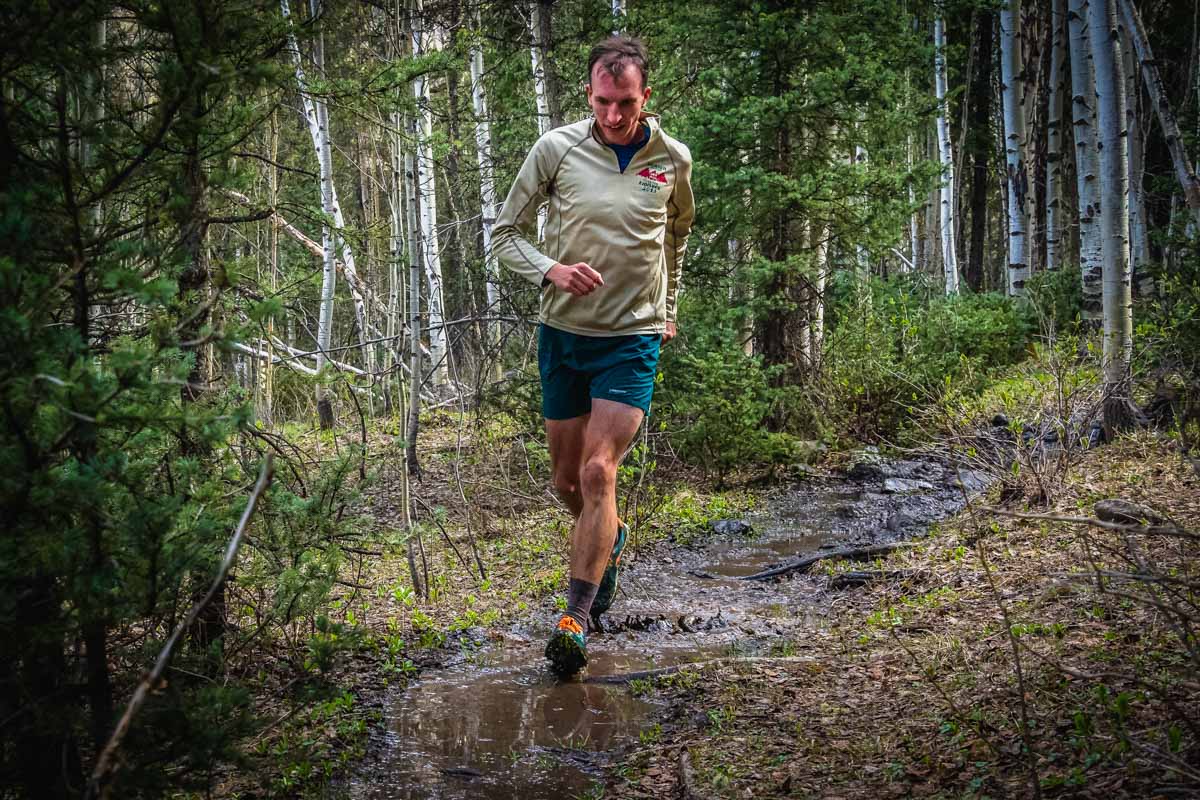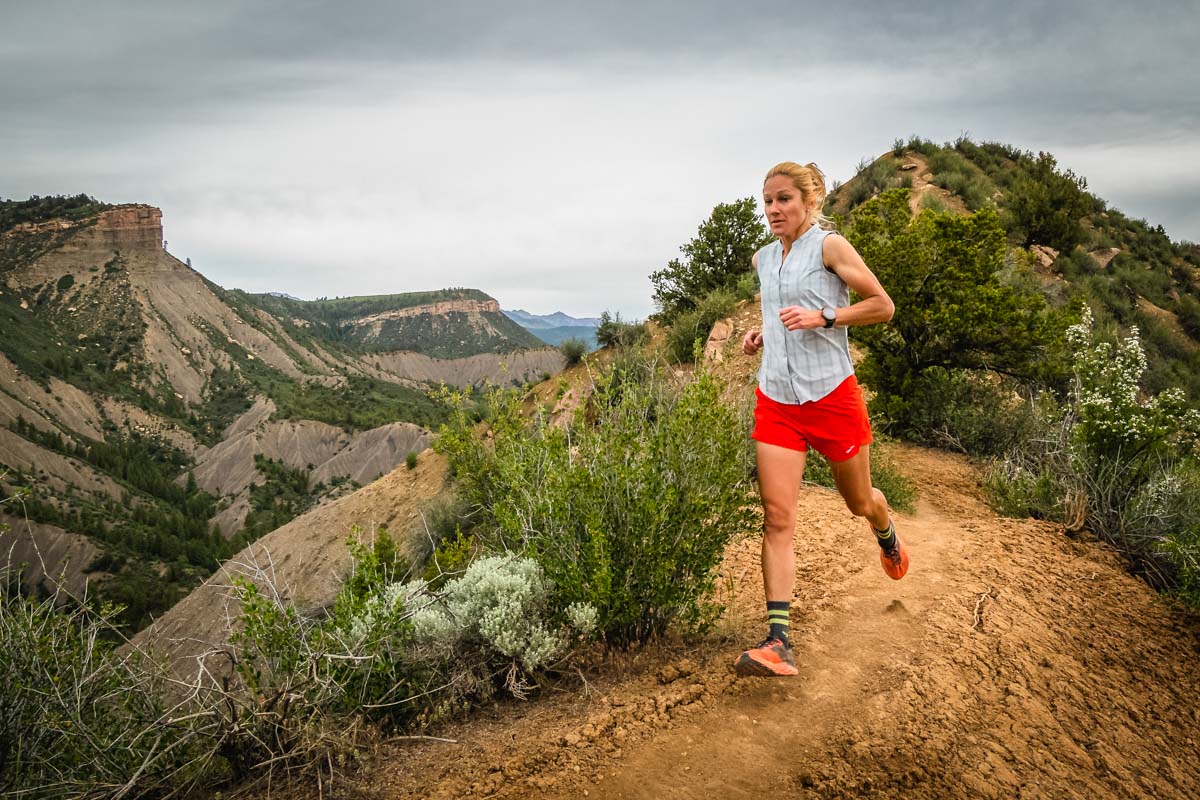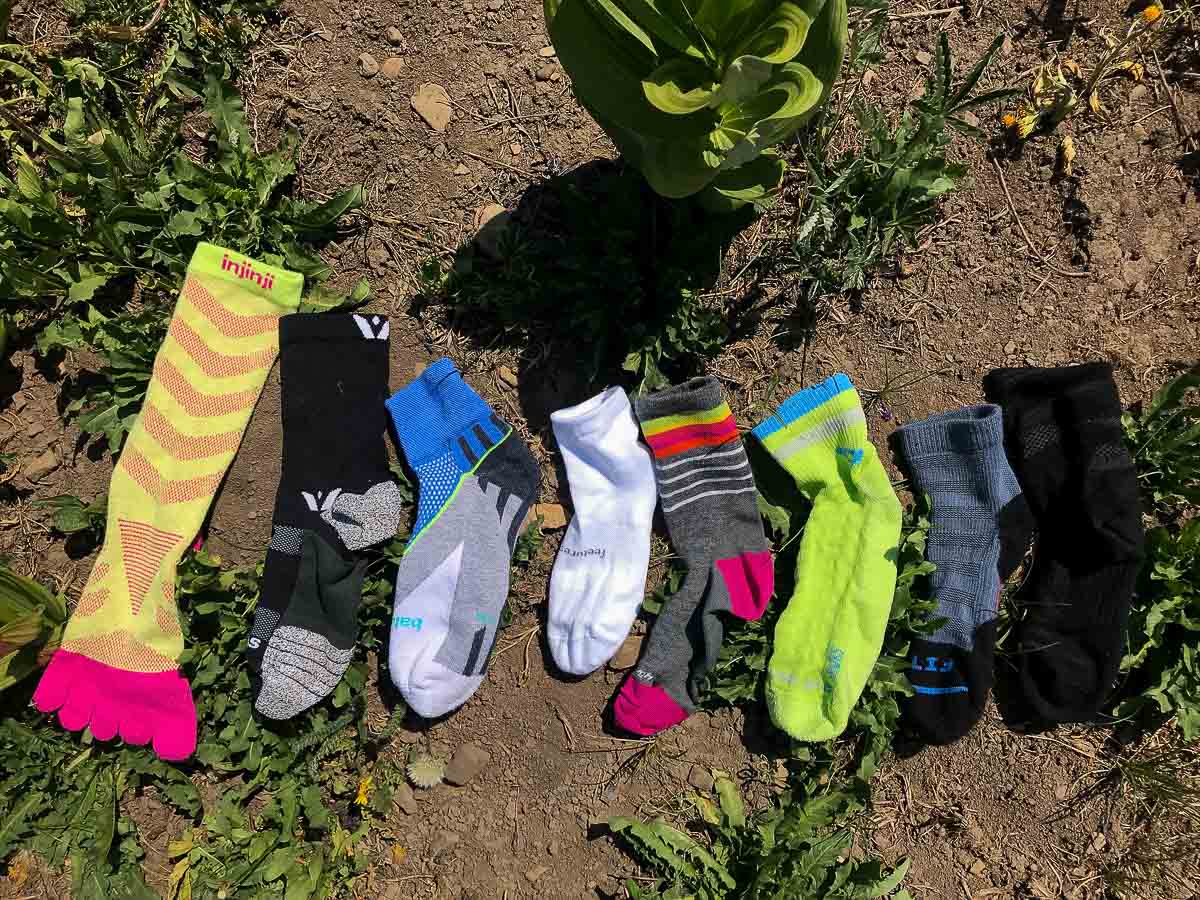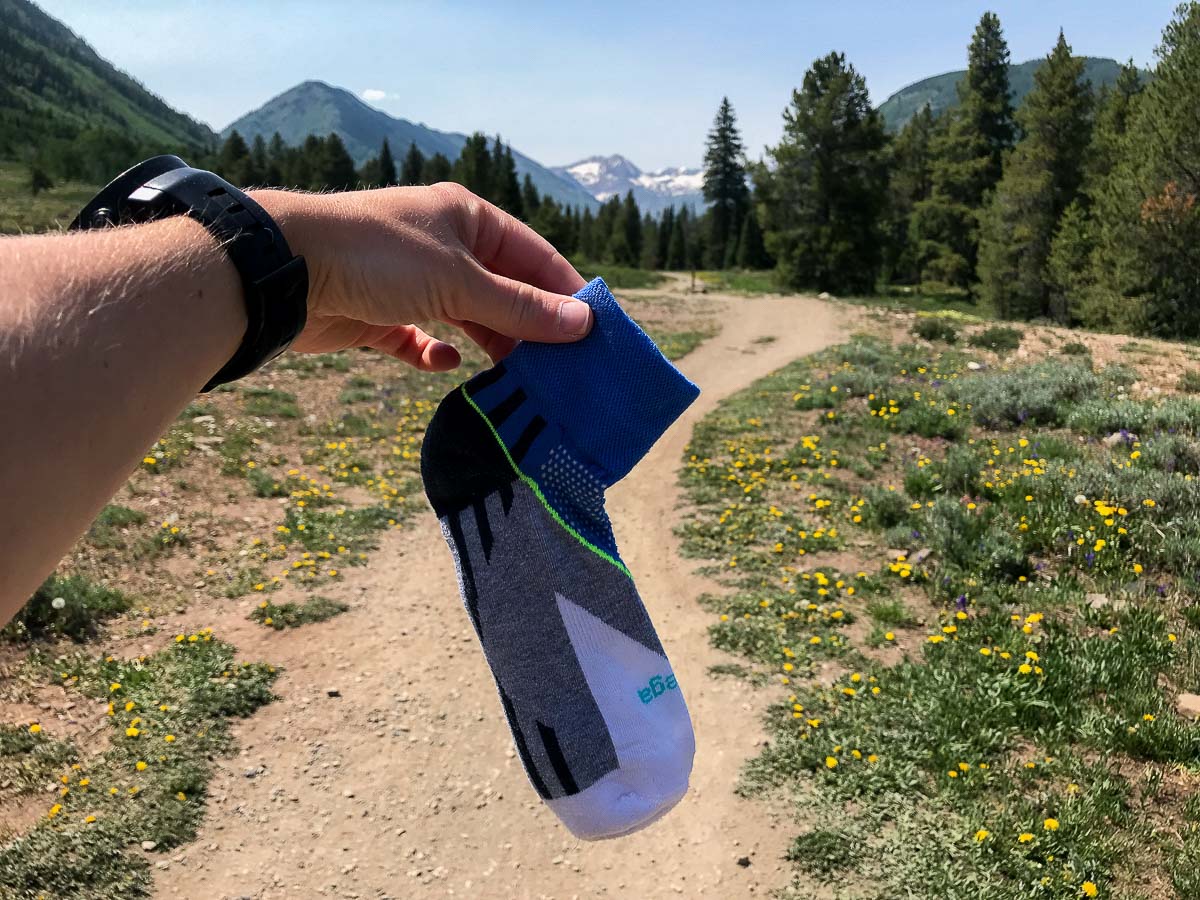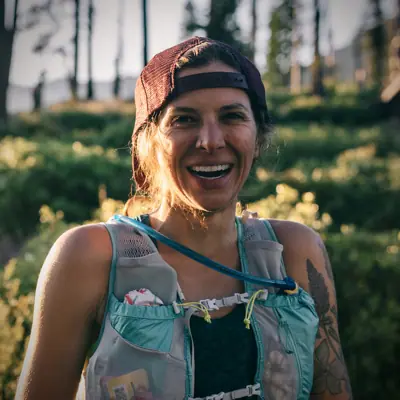After hundreds of trail miles from 14,110-foot Pikes Peak in Colorado to Moab, Utah’s rolling sandstone, we honed in on the best running socks for trail runners and ultrarunners — zero blisters included.
One of the most important pieces of gear for runners is our socks. Well-constructed, tailored running socks are generally more expensive than cheaply woven silhouettes — for good reason. Each athletic stocking that we put on is strategically designed with a scientific curation of fibers for moisture management, heat transfer, placement and depth of cushion, and height. Each sock is created for specific conditions: toasty canyons, winter squalls, or bushwhacking up steep and long-forgotten singletrack. A better-made sock also survives more miles through the wilderness and on back roads than a bargain design.
The problem with top-tier running socks is the cost — four solid pairs could cost a big wad of cash. How can runners choose which pairs to buy? We produced this guide to help jumpstart your considerations. Over the past months, our six-member squad of professional, competitive, collegiate, and recreational trail runners and ultrarunners pulled on a range of hosiery for hundreds and hundreds of miles. The team included runners training for myriad races, from the Run Rabbit Run 100 Mile to the 40-mile Grand Traverse Mountain Run. We ran from dusk to dawn across the Rocky Mountains and the Western United States facing dust, sun-baked singletrack, snow, and rain.
Scroll through to see all of our recommendations for the best running socks. Also, learn more about our testing methodology, read our advice for choosing your next running socks, and see our frequently asked questions about running socks at the bottom of this guide.
Best Running Socks
- Best Overall Running Socks: Swiftwick Flite XT Five
- Best Running Socks – Runner-Up: Smartwool Athlete Edition Run Print Crew Socks and Smartwool Women’s Athlete Edition Run Print Crew Socks
- Best Budget Running Socks: Balega Enduro Quarter
- Best Running Socks for Hot Weather: Drymax Extra Protection Hawks Hot Weather 1/4 Crew Socks
- Best Running Socks for Cold Weather: Smartwool Run Cold Weather Targeted Cushion Crew Socks and Smartwool Women’s Run Cold Weather Targeted Cushion Crew Socks
- Softest Running Socks: Le Bent Ultra Light Mini Trail Sock
- Best Compression Running Socks: Swiftwick Aspire Four
- Best of the Rest Running Socks: Injinji Ultra Run Mini-Crew and Injinji Women’s Ultra Run Mini-Crew, Fits Micro Light Runner (Track) – Quarter, and Stance Run Light Crew Socks
Best Overall Running Socks: Swiftwick Flite XT Five ($24)
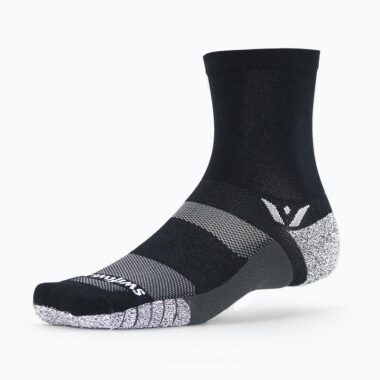 Why It’s a Top Pick: The Swiftwick Flite XT Five is a snug-fitting, compression-feel, no-budge sock with a soft touch, excellent breathability, and thumbs-up ankle protection.
Why It’s a Top Pick: The Swiftwick Flite XT Five is a snug-fitting, compression-feel, no-budge sock with a soft touch, excellent breathability, and thumbs-up ankle protection.
The Swiftwick Flite XT Five received the highest average score out of all of our socks and is one of the best running socks for runners, according to our male- and female-identifying testers. Our biggest take-home from the Swiftwick Flite XT Five is that these socks give our feet and ankles a mega hug. The design features moderate compression, which feels snugger than most running socks like the Drymax or Smartwool models in this guide. The result? No bunching at all and a slight squeeze. Note, however, these socks do not have medical-grade compression.
Nonetheless, runners with meatier calves might need a short break-in period with this muscular sock. “They were a little tight around my lower leg to start. Once I spent time in them, they stretched, held shape to my lower leg, and I did not feel restriction at all,” said one competitive ultrarunner and product tester. The runner donned these socks for 160 miles in temperatures ranging from 32 to 92 degrees Fahrenheit in Colorado and Utah. “These are by far my favorite socks. It was more than 90 degrees Fahrenheit when I ran in Moab, and my feet did not feel sweaty or wet.”
The mesh upper helps to release heat. A medium-level cushion sits beneath the arch and heel, which we found provides adequate protection mile after mile and on rocky descents. The fabric below the forefoot has alternating rows of cushion — which feature a proprietary grippy fiber called olefin to wick away moisture and sweat. The grippy nanofiber is also mixed into the heel cushion and provides no-slip stability in our testers’ shoes. After plowing through water, “These socks dried out really fast and did not give me any blisters,” and the four-inch high cuff “is perfect for running through grass and low brush,” reported one tester. Overall, “These socks are super comfortable, really soft, and make my feet feel so secure.”
Material: 66% nylon, 17% polyester, 14% olefin, 3% spandex
Pros:
- Snug and secure
- Manages moisture super well and dries fast
Cons:
- Large calves might require a break-in period
- Higher cost
Best Running Socks – Runner-Up: Smartwool Athlete Edition Run Print Crew Socks and Smartwool Women’s Athlete Edition Run Print Crew Socks ($27)
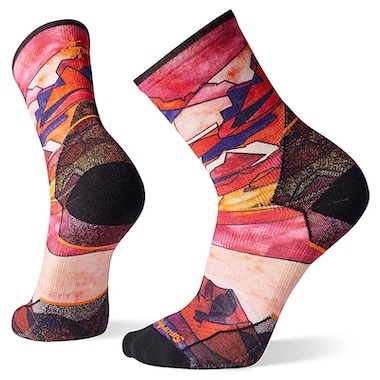 Why It’s a Top Pick: The lightweight Smartwool Athlete Edition Run Print Crew Socks and the Smartwool Women’s Athlete Edition Run Print Crew Socks have our favorite strategically placed cushioning, which is dense and ultralight, plus a cuff height that protects the ankles and lower legs on trail runs.
Why It’s a Top Pick: The lightweight Smartwool Athlete Edition Run Print Crew Socks and the Smartwool Women’s Athlete Edition Run Print Crew Socks have our favorite strategically placed cushioning, which is dense and ultralight, plus a cuff height that protects the ankles and lower legs on trail runs.
The Smartwool Athlete Edition Run Print Crew Socks ranked a close second place among our top-rated picks — it even received a perfect score from one of our testers. Clearly, this design has been and is still among the best socks for runners. This design is lightweight, with light cushion that’s far from flimsy. From mud-ridden, high-altitude routes to arid desert floors, we found this streamlined sock provided excellent and strategic protection. The sock has a targeted, thin, tightly woven cushion beneath the ball of the foot, heel, around the toe, behind the Achilles tendon, and against the outer ankle — in all the necessary spots.
The top of the foot and cuff are a mesh blend for ventilation, which dissipates heat fairly well — though not as well as the Drymax Extra Protection Hawks Hot Weather 1/4 Crew Socks in this guide. That said, this Smartwool design transferred moisture well and didn’t become soaked from perspiration, even with the sweatiest testers. The height rises nearly four inches above the ankle, and the toebox is seamless with no bunching fabric.
One of our testers took this pair on multiple long-distance runs in a row and never noticed a stench, thanks to the odor-absorbing merino wool. Ultimately, the Smartwool Athlete Edition Run Print Crew Socks are crisp, well-tailored running socks, ideal for short or long trail runs, moderate temperatures, and multi-day trips. Plus, “the seams on the inside of this sock are pristine with no free-flying threads, and the sock has the perfect amount of elasticity. My foot feels cradled and comfortable,” shared one of our testers.
Material: 57% merino wool, 38% nylon, 4% elastane, 1% polyester
Pros:
- Attractive, stylish design
- Durable
Cons:
- Lightweight but not a prime choice for the hottest weather
- Higher price tag
Shop the Smartwool Athlete Edition Run Print Crew SocksShop the Smartwool Women's Athlete Edition Run Print Crew Socks
Best Budget Running Socks: Balega Enduro Quarter ($16)
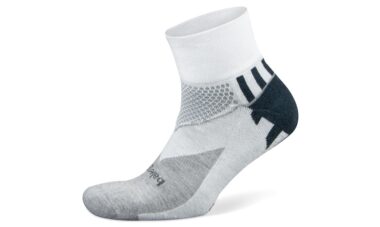 Why It’s a Top Pick: The Balega Enduro Quarter provides medium-cushion support while being a breathable, moisture-wicking, no-budge budget option compared to our other top picks.
Why It’s a Top Pick: The Balega Enduro Quarter provides medium-cushion support while being a breathable, moisture-wicking, no-budge budget option compared to our other top picks.
The Balega Enduro Quarter is our favorite medium-cushion sock for additional protection beneath our heel, arch, forefoot, and toes. “I like a bit more cushion on mountain trail runs, especially if I’m on a huge descent. This medium-level cushion is a nice, plush break from lighter socks with lightweight cushions, which I also like to wear on runs. Even though this cushion is on the thicker side, it doesn’t twist, bunch, or lead to blisters,” said one product tester who took these socks on mountain runs statewide in Colorado.
This midweight sock feels heavier than most other warm-weather socks in our guide but is surprisingly breathable and transfers moisture well. “My feet felt slightly warm post-run but did not feel too warm during the run, and I was on a sun-exposed trail on an 80-degree Fahrenheit day at 9,000 feet above sea level. The socks never felt muggy or murky and dried fast,” noted one runner who tested the socks in Colorado’s Gunnison Valley. The runner also wore another pair of Balega Enduro Quarter socks for four seasons before the heels wore down. The elasticity also retains value over time. Plus, the toebox is roomy, comfortable, and doesn’t bunch or shift.
A potential caveat for some runners: These socks don’t squeeze your feet like the Swiftwick, Le Bent, or Smartwool pairs listed in this guide.
Material: 91% Drynamix polyester, 7% polyamide, 2% elastane
Pros:
- Medium-cushion choice
- Breathable and wicks moisture well
- Fabric doesn’t bunch or slouch
- Economic price
Cons:
- Lacks ankle protection
- No compression
Best Running Socks for Hot Weather: Drymax Extra Protection Hawks Hot Weather 1/4 Crew Socks ($26)
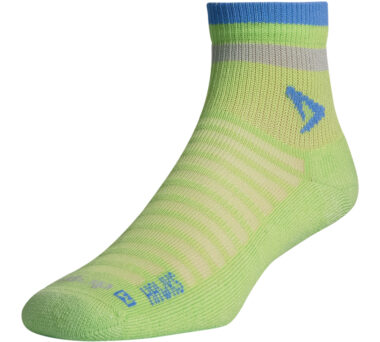 Why It’s a Top Pick: The Drymax Extra Protection Hawks Hot Weather 1/4 Crew Socks is a lightweight, very breathable sock that resists heat buildup during hot, sun-exposed runs and races.
Why It’s a Top Pick: The Drymax Extra Protection Hawks Hot Weather 1/4 Crew Socks is a lightweight, very breathable sock that resists heat buildup during hot, sun-exposed runs and races.
The Drymax Extra Protection Hawks Hot Weather 1/4 Crew Socks are extremely breathable and provide reprieve on sunny, hot, or intense runs, according to several of our gear testers. “This is a great thinner sock for warmer trail days or races. It’s very breathable with the right amount of elasticity and cushion,” noted one long-distance runner and coach, who wore the socks on mountain trails and old mining roads in Colorado’s Elk Mountains. The upper side of the sock features a mesh weave that dumps heat. A consistent layer of moderate padding stretches along the bottom of the foot, from heel to toe, beneath the metatarsals, which provides excellent protection and comfort.
The fabric blend includes a Teflon fiber — polytetrafluoroethylene (PTFE) — that is among the best synthetic materials for withstanding friction, according to the Polymer Properties Database. The PTFE is located in the heel, forefoot, and toe areas, which are super durable. One professional mountain runner and product tester has used a pair for three years and notes no visible wear and tear. He added, “The slim fit works well with snugger-fitting shoes,” and the lower quarter-crew length sits an inch above the ankle, which is generally preferred for toasty jaunts. The fiber blend also includes olefin, which wicks away moisture and sweat.
Overall, our team experienced no blisters, slippage, or lingering odors after pounding miles with these socks. The interior of the toebox was smooth and went unnoticed. Critique? The socks aren’t the softest in the drawer, highlighted one tester, “While I don’t feel any friction or hot spots with these socks, the tradeoff is that they feel a bit coarse — they aren’t very soft.”
Material: 36% Drymax olefin, 26% polytetrafluoroethylene (PTFE), 22% polyester, 12% spandex, 4% nylon
Pros:
- Lightweight
- Excellent ventilation
- Tenacious, long-lasting fabric
Cons:
- Not a sock for colder days
- Looks thick and cumbersome
- Pricier
Best Running Socks for Cold Weather: Smartwool Run Cold Weather Targeted Cushion Crew Socks and Smartwool Women’s Run Cold Weather Targeted Cushion Crew Socks ($23)
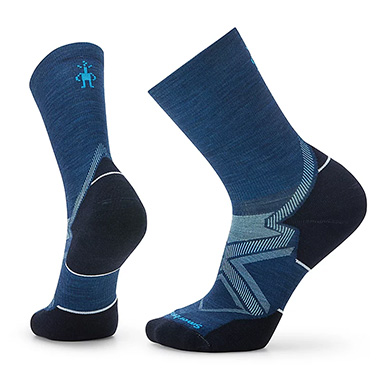 Why It’s a Top Pick: The Smartwool Run Cold Weather Targeted Cushion Crew Socks and Smartwool Women’s Run Cold Weather Targeted Cushion Crew Socks are athletic, thicker, heat-retaining socks for colder conditions with targeted light cushion and a cuff that safeguards ankles and lower legs.
Why It’s a Top Pick: The Smartwool Run Cold Weather Targeted Cushion Crew Socks and Smartwool Women’s Run Cold Weather Targeted Cushion Crew Socks are athletic, thicker, heat-retaining socks for colder conditions with targeted light cushion and a cuff that safeguards ankles and lower legs.
This heavier weave sock is a concrete choice that braces against the elements of cold weather, snow, or rain, and winter runs on dirt roads, pavement, or trail. The Smartwool Run Cold Weather Targeted Cushion Crew Socks reach a few inches above the ankle. Our team enjoyed the integrated light cushion in the heel and front-of-foot and didn’t experience any blisters, foot slippage, or lingering smells post-run.
“The merino wool combination is great at keeping the moisture out, and the socks feel ventilated during a run,” celebrated one product tester and run coach, who donned this pair for runs in Colorado’s Elk Mountains. The socks are very stretchy, and the toebox isn’t restrictive.
Another tester, who wore this pair all over Colorado’s San Juan Mountains, noted that the “extra cushioning added protection but also soaks up more liquid if you get your feet wet while running in slushy snow.” Thankfully, even when these socks are wet, they rock at retaining heat.
Overall, the fit is athletic, and the design is extremely comfortable. One of our testers even voted this pair among the best all-around socks: “These socks felt so good I would forget they were even on. That’s exactly what you want in a sock — one that gets the job done, and you don’t have to think about them. The wicking power of the merino wool in these socks is definitely a game-changer for overall comfort on both cooler and warmer days. I also love the length to help keep debris out while trail running.”
The women’s-specific fit for this sock has a narrower heel and slimmer silhouette. Our male- and female-identifying runners tallied good scores for this sock, ranking it among the best running socks for men and women.
Material: 56% merino wool, 41% nylon, 3% elastane
Pros:
- Retains heat for cold days
- Stretchy
Cons:
- Extra material doesn’t pair well with snug-fitting shoes
- Sock thickness might not be a good choice for feet that swell
Shop the Smartwool Run Cold Weather Targeted Cushion Crew SocksShop the Smartwool Women's Run Cold Weather Targeted Cushion Crew Socks
Softest Running Socks: Le Bent Ultra Light Mini Trail Sock ($21)
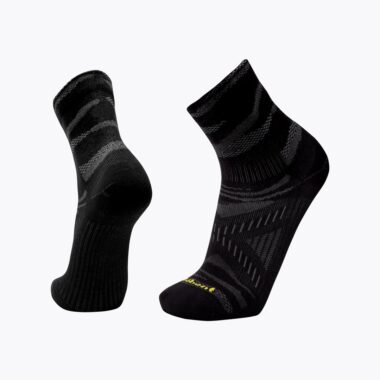 Why It’s a Top Pick: The Le Bent Ultra Light Mini Trail Sock is a supremely soft running sock that is comfortable, lightweight, and breathable.
Why It’s a Top Pick: The Le Bent Ultra Light Mini Trail Sock is a supremely soft running sock that is comfortable, lightweight, and breathable.
Yes, even our feet deserve buttery smooth apparel. The low-profile Trail Ultra Light Mini Trail Sock, made by Le Bent, fits the bill. The single most prevalent fiber in this super-soft sock is derived from bamboo, which is converted through a chemical process into a natural-based synthetic material. “Soft, soft, soft! The fibers are exceptionally soft against the skin. And the toebox and heel are seamless and don’t feel bulky,” shared one runner and veteran sock tester.
The sock doesn’t twist, bunch, or slip while on the go despite being the most supple choice in our guide. Our team took this sock on runs around Wyoming and Montana through thick pine forests, pebble-strewn paths, rocky trails, and lakeside beach sand. We found no loose threads or cumbersome seams. Mesh in the upper is a port for ventilation. The cuff — which reaches three inches above the ankle — has just-right elasticity, so no fabric slumping occurs while being jostled on rugged descents. The Le Bent Ultra Light Mini Trail Sock is a comfortable, luxurious-feeling sock that still rebounds well. The toebox feels a bit narrower than other socks like the Smartwool Athlete Edition Run Print Crew Socks.
Improvements? We’d like to see an iteration of this sock with moderate cushion. “This is a go-to thin, comfortable sock for warm-weather days and shorter to moderate distances. This sock lacks the cushion I prefer for super-long mileage,” said one sock tester. All considered, this pair is moderately priced compared to others on our list, and it’s worth adding to our sock queue.
Material: 44% rayon from bamboo, 35% nylon, 19% merino wool, 2% elastane
Pros:
- Very soft
- Moderate price
Cons:
- Minimal cushion
- Thin fabric could wear down after a couple of seasons
Best Compression Running Socks: Swiftwick Aspire Four ($19)
 Why It’s a Top Pick: The lightweight Swiftwick Aspire Four provides extremely supportive compression, wicks moisture well, and has very light cushion.
Why It’s a Top Pick: The lightweight Swiftwick Aspire Four provides extremely supportive compression, wicks moisture well, and has very light cushion.
The Swiftwick Aspire Four delivers the same primo moisture-wicking power as the Swiftwick Flite XT Five, reviewed above in this guide, but with super minimal cushion and more compression. We found the mesh footbed and upper — which is also constructed with olefin, a fiber that wicks away moisture and sweat — is effective and helped our feet stay dry. The fabric blend is soft against the skin. The cuff height sits four inches above the ankle, and we enjoyed the tight compression around the ankle, arch, and lower leg.
A caveat: we found that the thick cuff didn’t release heat very well. “The fabric above my ankle felt a bit thick and stuffy on a 70-degree Fahrenheit summer evening while wearing trail running shoes with a well-ventilated mesh upper. I was in shorts and a t-shirt, so I was not overdressed, but my feet felt noticeably hot. Otherwise, I really like the protection and brace the cuff provides,” shared one tester who took these socks on rocky, dusty singletrack and dirt roads around central Colorado. Our testers also wish this model had a tad more cushion but really enjoyed this sock for shorter mileage.
Overall, this pair is a solid choice for runners who want very minimal padding underfoot and a supportive squeeze that helps hold their ankle and arch.
Material: 67% nylon, 28% olefin, 5% spandex
Pros:
- Supreme elasticity
- Less pricey compared to our other top picks
Cons:
- Minimal cushion
- Non-ventilated cuff
Best of the Rest Running Socks: Injinji Ultra Run Mini-Crew and Injinji Women’s Ultra Run Mini-Crew ($18)
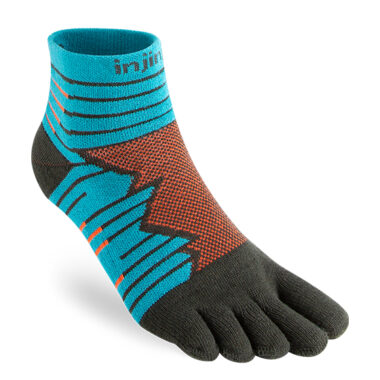 For some runners, toe socks are heaven’s answer to their longest ventures and daily miles. Theoretically, fabric wrapped around each toe keeps digits from brushing against each other and causing blisters. The fiber also splays the toes out, which can encourage toes to engage while on a run. According to our testers, the Injinji Ultra Run Mini-Crew and the Injinji Women’s Ultra Run Mini-Crew is a very protective, comfortable, and cushioned design. The women’s-specific version offers the same features in a narrower profile. Our female- and male-identifying runners provided similar good scores for the Injinji design.
For some runners, toe socks are heaven’s answer to their longest ventures and daily miles. Theoretically, fabric wrapped around each toe keeps digits from brushing against each other and causing blisters. The fiber also splays the toes out, which can encourage toes to engage while on a run. According to our testers, the Injinji Ultra Run Mini-Crew and the Injinji Women’s Ultra Run Mini-Crew is a very protective, comfortable, and cushioned design. The women’s-specific version offers the same features in a narrower profile. Our female- and male-identifying runners provided similar good scores for the Injinji design.
The Injinji Ultra Run Mini-Crew has a soft and cushioned, midweight fabric around the toes, which is made with terry, a thread technique often used for towels. The footbed also has cushion. The mesh top is designed to release heat, though one competitive ultrarunner and tester found that the socks were hot for faster road runs versus on trails. Despite the heat buildup, the moisture transfer was excellent, and the socks never got drenched with sweat. The fabric didn’t slip and never bunched. By the end of long runs, the elasticity in these socks was still top-notch, and the fabric didn’t retain odor.
For other runners, the toe sock is super supportive but boasts a bit too much material for long distances, technical and steep terrain, or streamlined footwear. “Despite being well-cushioned and soft, this style of sock is too stout for my personal preference. The thickness between my toes was apparent when running downhill, on rocky terrain, and at the end of long runs,” said one tester who typically reaches for lightweight socks with minimal cushion. She added, “There was too much fabric between my toes and around my pinky toe — I have a ridiculously short pinky toe. Toward mile 15, I would start to feel the fabric rubbing inside my pinky toes.” Our testers reported no hot spots or blisters despite the beefy fabric — especially around itty-bitty toes.
Material: 64% nylon, 33% CoolMax, 3% Lycra
Pros:
- Great cushion
- Solid moisture transfer
- Excellent coverage and protection
- Zero seams
Cons:
- Hot for pavement
- Thick compared to other lighter-weight running socks
- Not the best choice for footwear with a narrower toebox
- Short and tiny or high-volume toes are the least compatible with these socks
Shop the Injinji Ultra Run Mini-CrewShop the Injinji Women's Ultra Run Mini-Crew
Best of the Rest Running Socks: Fits Micro Light Runner (Track) – Quarter ($20)
 The Fits Micro Light Runner (Track) – Quarter provides one of the shortest cuffs in our guide with a one-inch rise above the ankle. For trail runs with less vegetation and technicality, this sock’s fabric coverage provides basic, adequate protection while letting our lower legs enjoy the air — especially on sunny, hot midsummer runs.
The Fits Micro Light Runner (Track) – Quarter provides one of the shortest cuffs in our guide with a one-inch rise above the ankle. For trail runs with less vegetation and technicality, this sock’s fabric coverage provides basic, adequate protection while letting our lower legs enjoy the air — especially on sunny, hot midsummer runs.
This lightweight sock delivers the best medium-grade cushioning in our guide. Targeted plush material is woven around the toebox, beneath the forefoot, and around the heel for protection on trail runs. This design provides more cushion and feels thicker than the Smartwool Athlete Edition Run Print Crew Socks, for instance.
Thanks to good elasticity, the sock cuff and arch stay put and don’t loosen, twist, or slouch over time. The toebox fabric doesn’t bunch, yet it feels less snug than the Le Bent Ultra Light Mini Trail Sock or Swiftwick models listed above. We didn’t notice any odors in the sock despite sweaty, sun-exposed runs due to the high quantity of merino wool, which absorbs odor. The fabric blend features superfine wool.
Our critique: “It’s not annoying or uncomfortable, but the interior seams of the sock have visible, long strands and aren’t as clean as the inside of other socks like the Smartwool Athlete Edition Run Print Crew Socks. Also, this fabric blend isn’t the softest I’ve felt,” reported one tester — perhaps due to the high quantity of wool, albeit not itchy. They added, “Overall, I still love these socks for the blend of lightweight, well-ventilated fabric and more cushion than other light socks I’ve worn.” Ultimately, we enjoy and want this sock in our toolbox for breezy comfort on less technical trail runs.
Material: 70% superfine merino wool, 23% nylon, 4% polyester, 3% Lycra
Pros:
- Shorter cuff option for less technical trails
- Lower price compared to other top-tier socks in our guide
Cons:
- Not the softest fiber blend
- The cuff isn’t super tall for ankle protection on technical, heavily vegetated trail runs
Best of the Rest Running Socks: Stance Run Light Crew Socks ($20)
 Rounding out our favorite socks for running is the Stance Run Light Crew Socks. With five inches of cuff height above the ankle, this sock is ideal for runners logging long miles on dusty trails or in mud who love a thin, quick-drying sock. It’s also super lightweight and breathable, thanks to the heavy dose of nylon in its synthetic blend.
Rounding out our favorite socks for running is the Stance Run Light Crew Socks. With five inches of cuff height above the ankle, this sock is ideal for runners logging long miles on dusty trails or in mud who love a thin, quick-drying sock. It’s also super lightweight and breathable, thanks to the heavy dose of nylon in its synthetic blend.
At the same time, we’re impressed with its durability. One of our ultrarunner testers has put hundreds of trail miles on this sock, running over volcanic scree and granite-strewn ridges, through creek crossings, and even traversing cow pastures while racing in Europe. “This sock has become my go-to for long mountain runs and ultras because it’s so breathable, and it doesn’t budge while I’m wearing it. I also appreciate its height since I tend to kick the inside of my ankles and calves late in a run when I’m very, very tired,” shared our tester. “I’m very hard on these socks, and they show zero wear.”
While the Stance Run Light Crew Socks provide a hug-like squeeze, and we had no reports of blisters or hot spots, it’s not quite as soft as the Swiftwick Flite XT Five or the Le Bent Ultra Light Mini Trail Sock, which we reviewed in this guide. Further, it’s a super thin sock with very little cushioning, so those who prefer a bit more fabric under their feet may want to opt for the Drymax Extra Protection Hawks Hot Weather 1/4 Crew Socks or the Smartwool Athlete Edition Run Print Crew Socks, both of which offer a targeted cushion in a light, well-ventilated design — they are also among our top socks in this guide.
Material: 72% nylon, 18% polyester, 5% elastane, 5% combed cotton
Pros:
- Moderate compression
- Good ventilation
- Durable
Cons:
- Minimal cushion
- Not as soft as our top picks
Frequently Asked Questions about Running Socks
Should running socks be thick or thin?
The perfect amount of material in a running sock is based on personal preference, which is also influenced by a runner’s preferred footwear. Running shoes with a narrower toebox and more streamlined fit often pair best with lighter-weight socks like the Swiftwick Aspire Four or Stance Run Light Crew Socks. Also, some runners’ feet tend to swell in hotter conditions or during long-distance runs, so thicker socks can become too cumbersome. In winter running conditions, the foot protection provided by a thicker sock like the Smartwool Run Cold Weather Targeted Cushion Crew Socks is preferable.
Additionally, foot volume influences runners’ preferred sock thickness. Some people with low-volume feet find that thicker socks allow them to lock into certain shoes better. Other runners with high-volume feet might be limited to thinner socks, as their feet already occupy most of a shoe’s available volume.
How long do running socks last?
The lifespan of running socks depends on many factors, including the quality and type of materials woven into the sock and how the socks are used. All fibers break down over time from sunlight, moisture, the oils of human skin, the inherent wear-down inside our running shoes, brushing against shrubs, and wash-and-dry cycles. In general, synthetic fibers are more durable, stain resistant, and last longer than natural fibers. The durability of the Stance Run Light Crew Socks landed it as one of our Best of the Rest socks.
Following laundering instructions can help make socks last longer. For instance, socks with terry loops will re-fluff when dried in a dryer, and their care instructions will note to tumble dry. Other socks shouldn’t be machine dried because high heat affects the fiber integrity. Also, using a detergent that’s not recommended can decrease a sock’s perceived functionality, as the product’s residue can decrease breathability.
Wearing the proper size sock and keeping your toenails trimmed can also help reduce wear. And, of course, walking inside or outside in socks without shoes on can deteriorate the fabric as well. While we are elated when our run socks last two or three seasons, we’re not surprised if they’re barreled after one.
Should I wear compression socks for running and recovery?
Post-run, compression socks support blood circulation in a runner’s legs, which helps prevent and reduce swelling. Some evidence also shows that compression socks worn during a run can positively impact performance on the athlete’s next run and aid recovery, according to the Cleveland Clinic, a premier academic medical center based in Cleveland, Ohio. The thick material and tall socks can also help protect the lower leg and ankles from shrubs, sunshine, rain, snow, or harsh wind.
Most importantly, if compression socks make you feel good during a race or on a run, it’s likely a good idea to add them to your kit. The best compression socks for running are the ones that best fit your feet and calves: they should feel snug but not too tight. The Swiftwick Aspire Four socks provide compression for just your feet and can provide benefits without being tall.
Compression socks are produced in a range of tightness levels from eight millimeters of mercury (mmHg) to 50mmHg. Silhouettes made for runners, such as the tall compression socks made by Cep or Pro Compression, typically offer 20 to 30 mmHg.
Such socks also generally feature graduated compression, meaning they are tightest at the ankle and become gradually looser further up the leg.
If you have any health concerns, speak with your healthcare provider before investing in compression socks. For instance, diabetic patients can experience complications while using compression socks, according to the Oklahoma Heart Institute in Tulsa, Oklahoma. Note we did not include medical-grade compression socks in this sock guide.
Should I wear special socks for cold and hot weather?
When you run in hot weather, it’s best to pull on thinner, breathable, moisture-wicking socks. When you run in cold weather, thicker socks that are still fairly breathable and moisture-wicking will be ideal. If there is precipitation, it’s good to choose a pair that retains heat even when they are wet, such as socks with a wool blend.
A taller sock height is a good choice for cold weather. In hot weather, the sock height depends on the amount of fabric preferred to protect against vegetation, though it’s not good to choose a sock cuff that’s so short it doesn’t stay fixed against the ankle. For all seasons, choosing a pair of socks with at least a minimal cushion will provide protection and comfort for the underside of the foot from the toes to the forefoot to the heel. A bit more cushion will inherently provide a tad more warmth, too.
Our favorite socks for cold weather are the Smartwool Run Cold Weather Targeted Cushion Crew Socks, and we love the Drymax Extra Protection Hawks Hot Weather 1/4 Crew Socks in hot weather.
Can socks help prevent blisters?
Blisters are, in part, caused by friction where a part of the foot rubs against another part of the foot and/or the socks and shoes you’re wearing. Some runners experience blisters on their heels, while others find the painful nuisance on their toes or even the soles of their feet. It’s important to choose socks and shoes that fit well — and fit well together — in order to prevent hot spots that become blisters. If the hosiery has too much material or is too loose, the fabric can slip or shift, and the footwear or sock material can rub the foot. The snug fit and compression feel of the Swiftwick Flite XT Five can keep feet free from blisters by preventing any sort of rubbing.
The sock fibers can make a difference, too. One of our sock testers experienced blisters directly under her forefeet when she was doing downhill sprints, which were caused by the socks she wore that day that were made with nylon (75%) and elastane (13%), and the bottom of the sock was too slick. The best way to prevent horrible blisters is to take your socks out for a variety of shorter runs, from speedy sprints on flat paths to steep climbs and downhills, in order to make sure your feet and choice footwear operate well with that sock. And if you begin to experience hot spots or blisters, stop and address them immediately.
Finally, after choosing their favorite footwear and socks, some runners also apply lubricant, like Body Glide or Squirrel’s Nut Butter, to their feet before running. Curiously, blisters can be linked to hydration and electrolyte imbalances.
Read our in-depth article on blister care and prevention to learn more.
Buying Advice: How to Choose Running Socks
Material
The best running socks feature a blend of synthetic and natural materials. All socks need a percentage of nylon, polyester, or elastic in order to retain the shape, stretch, durability, and elasticity of the design. A handful of our favorite socks incorporate merino wool, a natural fiber grown by merino sheep. Studies show that this specialized wool reduces body odor, can benefit those who struggle with eczema, and is moisture-wicking and breathable, according to Woolmark, a nonprofit organization that works alongside Australia’s 60,000 woolgrowers to research, develop, and certify wool.
Then, a handful of our choice socks include unique fibers like olefin, polytetrafluoroethylene, and rayon from bamboo, which each enhance specific benefits like breathability, moisture management, and next-to-skin feel.
We recommend avoiding cotton. Cotton retains moisture, so as your foot builds heat in a running shoe, you’d be more likely to experience hot spots or blisters. Our one teeny tiny exception here is the Stance Run Light Crew Socks, which are majority nylon and contain 5% combed cotton.
Seams
One of the worst feelings in a sock is when the seams are irritating or abrasive.
When running socks are manufactured, they’re generally knit as a tube, then are finished off via a seam in the toe. The toe seam rests in a slightly different location for each sock, depending on the manufacturer’s design, but is usually above and on top of the toes with a closure alongside the outermost toes. The heel pocket also has a y-shaped seam.
Not every seam is created equal. Some seams are flatter and softer than others. The best seams in socks are the ones that go completely unnoticed.
Toe socks, such as the Injinji Ultra Run Mini-Crew, have no seams at all.
Wicking
In running socks, the majority of moisture-wicking yarns are synthetic. Synthetic fibers are hydrophobic, so they resist the penetration of moisture. In other words, they have stellar moisture-wicking properties. However, wool also has moisture-wicking properties: the core absorbs a small amount of liquid, the surface remains dry, and the wool wicks out the moisture. When it came to running in hot weather, we found that the Drymax Extra Protection Hawks Hot Weather 1/4 Crew Socks outperformed every other sock that we tested.
Thick Versus Thin Socks
In general, thicker socks like the Smartwool Run Cold Weather Targeted Cushion Crew Socks and Smartwool Women’s Run Cold Weather Targeted Cushion Crew Socks are a better choice for colder, more wintry, and weather-tossed conditions like rain and snow. Also, thicker socks often pair better with trail running shoes that are less streamlined and have a wider toebox. Light or medium-weight summer-weather socks with a medium-level cushion feel thicker than socks with an ultrathin or thin cushion. A medium-level cushion also feels softer beneath the foot. The ideal amount of cushion for a trail runner is based on personal preference and foot-health needs, as well as foot type. Narrow and low-volume feet often find that thicker socks enable more security in particular shoes. On the other hand, runners with high-volume feet sometimes prefer thinner socks because their feet fill the majority of a shoe’s interior.
Thin socks are a good choice for warmer conditions. Thin socks with minimal cushion also tend to work well with narrower, more precise footwear. For some runners, minimal socks provide a sense of enhanced foot control inside their footwear and while running technical terrain, especially if traversing loose rock or scrambling off-trail is involved in the route. A thinner cushion can feel firmer underfoot. If your feet tend to swell on runs or during a race, it’s important to account for the available real estate inside your shoe: a thinner sock might be a better choice.
Tall Versus Short Socks
Running socks come in a range of sizes for a variety of applications, from sidewalks to rugged mountain ridges. No-show and extra-low cuts sit at and below the ankle, and a quarter-length sock rests above the ankle. A crew size hits beneath the calf. And an over-the-calf or knee-high sock reaches just below the knee.
For the purpose of this guide, our team concluded that low-cut and no-show socks do not generally provide the best protection for trail runners and ultrarunners. A higher sock is desired to cover and protect the ankle and lower leg from flying dirt and pebbles, tall grass or brush, and abrasive rocks in outdoor terrain. That said, a low-cut sock has its purpose on particular runs, especially on the track or road with no vegetation or when it’s really hot.
On the opposite end of the spectrum, knee-high socks provide the most protection against the elements, so some trail runners and ultrarunners wear tall socks. Over-the-calf socks inherently feel warmer than shorter pairs. Tall socks can also feature graduated medical-grade compression: they are tightest at the ankle, become gradually looser further up the leg, and typically provide 20 to 30 millimeters of mercury of compression. Compression socks help increase blood circulation and prevent and reduce swelling, and some evidence shows that compression helps with recovery for future runs. We did not test knee-high socks or medical-grade compression socks for this guide.
The majority of our top-ranked socks are between a knee-high and a no-show. The most minimal height we agreed on is a quarter sock, meaning the ankle bone is entirely covered, and the sock rises one or two inches above the ankle, like the Balega Enduro Quarter and the Drymax Extra Protection Hawks Hot Weather 1/4 Crew Socks. A lower sock height is best for runs on designated trails.
Our highest-rated, most favorite socks for the majority of our runs from mountains to deserts are a range of crew heights that rise three to five inches above the ankle. One example is our best overall sock, the Swiftwick Flite XT Five.
Durability
The most durable running socks are manufactured with a blend of synthetic fibers, which help the sock maintain its form and support. Synthetic fibers are more robust, stretchy, and have a longer lifespan than natural fibers. This explains why every sock in our guide holds a percentage of synthetic material, even when mixed with natural fibers. The Drymax Extra Protection Hawks Hot Weather 1/4 Crew Socks use synthetic fibers designed to withstand friction to create a comfortable and highly durable sock.
A synthetic blend coupled with natural fibers is still a top choice for run socks because natural fibers provide specific qualities such as moisture transfer, breathability, odor resistance, or softness.
Performance socks, such as the ones in this guide, are reinforced with layers of abrasion-resistant fibers in high-use areas of the foot that normally wear down, like beneath the toe, Achilles area, and heel.
Why You Should Trust Us
We began this guide by polling the 20-plus-person iRunFar team with its collective hundreds of years of running experience about their favorite — and less favorite — running socks, as well as researching dozens of the highest-ranked, most popular, and top-selling socks for runners. In doing so, we honed a list of running socks for regimented testing.
Our six product testers covered hundreds of miles with these socks. Altogether, we followed rocky and smooth trails through high-altitude desert and mountain slopes, sandy singletrack, granite canyons, sun-beaten loops, dense aspen groves, crusty postholing ventures, and mud-caked routes. On some runs, we pounded pavement and packed dirt. Our runners endured frigid rain, blasts of snow, sunshine at 14,000 feet, and lip-chapping gales. We tracked miles through a range of environments across the San Juan Mountains, Elk Mountains, and Front Range of Colorado, as well as mountains and deserts throughout Utah, Wyoming, Montana, and the scree-strewn slopes of Oregon’s Cascade volcanoes.
Throughout each run, we meticulously examined the socks and ranked each sock on a 120-point scale that included 12 essential qualities from breathability, moisture transfer, and cushioning to overall protection and comfort. Based on the average scores, these seven socks are the front-runners: Swiftwick Flite XT Five, Smartwool Athlete Edition Run Print Crew Socks, Balega Enduro Quarter, Drymax Extra Protection Hawks Hot Weather 1/4 Crew Socks, Smartwool Run Cold Weather Targeted Cushion Crew Socks, Le Bent Ultra Light Mini Trail Sock, and Swiftwick Aspire Four. A handful of socks scored high in many (but not all) traits, while others we tested didn’t make the cut. We’re thrilled to report that none of our testers experienced blisters during the creation of this guide.
Please note that in the running world, product models are routinely discontinued, while new ones frequently come to market. At the same time, we here at iRunFar often keep using our top picks in our daily running … they’re our top picks, after all! Sometimes that continued use results in uncovering product failures. With all this — product discontinuations, product introductions, and product failures — in mind, we routinely update our buyer’s guides based on past and ongoing testing as well as research by our authors and editorial team. While these updates can appear to be us pushing the newest product, it’s anything but that. When we update any buyer’s guide, most of the products are likely to remain the same. That matches our goal: to get you in the best gear that you’ll be using for a long time.
Call for Comments
Is there a pair of awesome running socks that have made your runs that much better? Share it in the comments below for us to consider for future updates to this guide.
Back to Our Top Running Socks Picks